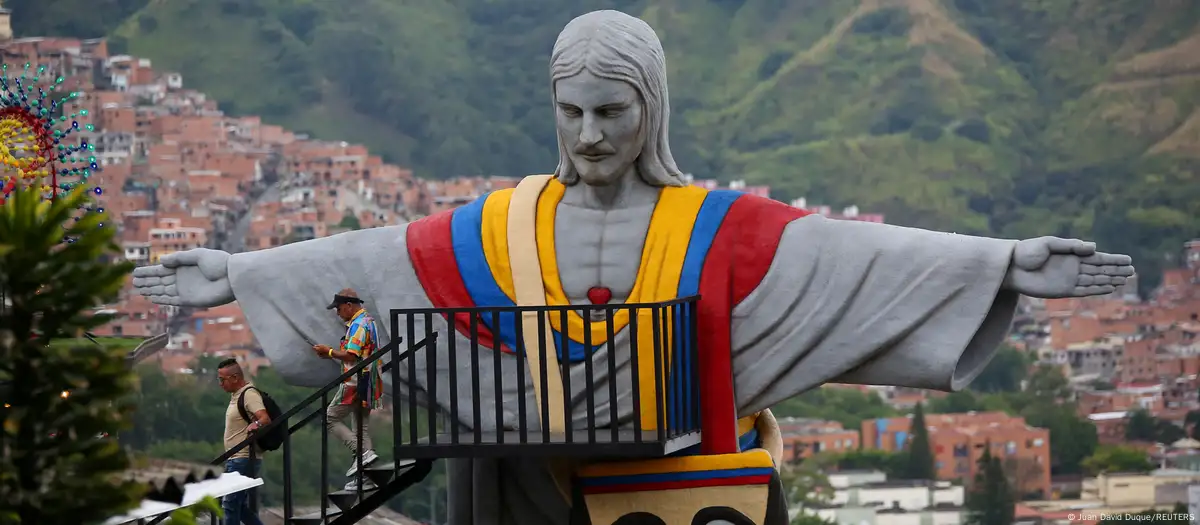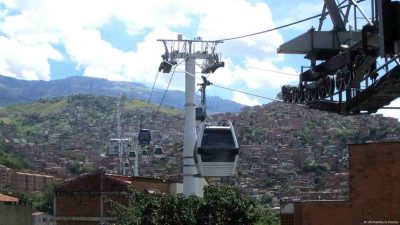
President of Colombia criticized the operation in Alemão and compared it with action in Comuna 13, which left dozens dead in the Colombian city in 2002. Contexts and impacts of the attacks differ between countries.
Police action in the Penha and Alemão complexes last week reignited comparisons with conflicts in urban areas observed in Colombia. As in Brazil, the territorial dominance of criminals was used as a justification for the intensive use of force in military operations in the neighboring country. The use of the security apparatus in Colombian communities has enjoyed popular support in the past, but has raised questions about human rights violations.
Last Wednesday (29/10), Colombian President Gustavo Petro criticized the conduct of the governor of Rio de Janeiro, Cláudio Castro, whose mega-operation left more than a hundred dead. “Just like the operation in Comuna 13 in Medellín”, he wrote, calling the Brazilian attack “barbaric”. The post, made on the social network X, refers to the so-called Operation Orión, from October 2002, which became one of the main milestones in the urban conflict in Colombia.
Ordered by former Colombian president Álvaro Uribe, the action in Comuna 13, then one of the most violent neighborhoods in Medellín, included a strong military apparatus.
The intention was to regain power in a territory occupied by guerrillas, including the Revolutionary Armed Forces of Colombia (FARC) and the National Liberation Army (ELN). For two days, the region recorded shootings supported by the use of helicopters. In the following months, the occupation continued and was marked by a series of arrests.
“The action was the product of military and political decisions, with the security forces using all possible tools, legal and illegal. At least 1,500 people were mobilized, including paramilitaries”, says Colombian journalist Ricardo Aricapa, author of the book Comuna 13: Crônica de uma Guerra Urbana.
Orión occurred after a series of other incursions into the territory that failed due to a lack of planning and were marked by high lethality.
The author says that the operation was widely supported, with the paramilitaries being received as a “blessing” by the local population and Colombian flags being displayed at the time. “At the time, around 80% of residents applauded the operation,” he states.
In turn, the action left a strong trail of rights violations, especially related to what in Colombia became known as “false positives”, when innocent citizens murdered by security forces were falsely identified as members of groups such as the FARC.
Once classified as one of the most dangerous urban communities, Comuna 13 has undergone urban and economic revitalization | Juancho Torres/AA/picture alliance
This occurred due to Uribe’s policies of bonuses for each guerrilla killed in confrontation with security forces. According to the Special Jurisdiction for Peace (JEP), more than 6 thousand people were victims of this type of action.
There is no consensus on the official death toll in Operation Orión. It is known, however, that it reaches dozens and also accumulates missing, injured and prisoners. According to Aricapa, hundreds of people were classified as “false positives” in the case of Comuna 13.
At the time, however, Medellín was experiencing a different context from the territorial dominance of organized crime in Rio de Janeiro, as it was facing an internal armed conflict between guerrillas, which exacerbated clashes with security forces. To this day, organizations demand answers about people missing during the operation.
Orión ended up becoming a landmark in the transformation of the city, which in the following years began to invest more broadly in infrastructure, social urbanism and mobility to better integrate Comuna 13 into the city. The police also underwent a subsequent process of modernization.
“Before 2002, Comuna 13 was one of the most abandoned regions, it didn’t even appear on maps. Transport was very poor for the region”, says Aricapa. Since then, public access policies have been put into practice, including an armed presence to guarantee stability in the territory.
“This opened space for the emergence of a cultural movement that ended up attracting tourism to the region, which was not the initial idea,” says Aricapa. Today, Comuna 13 has become an attraction in Medellín, also counting on socioeconomic investments and the installation of a series of NGOs that offer services to the local population and attract volunteers from various parts of the world.
Reference for Brazil
The cooling down of violence in Medellín became a reference for Brazilian authorities. During the administration of the former governor of Rio de Janeiro, Sérgio Cabral, the city served as inspiration for a series of urbanization measures implemented by the Rio de Janeiro government, such as the installation of cable cars and escalators in communities.
The similarities between Medellín’s topography and Rio de Janeiro help explain the attraction. Located in the Aburrá Valley, the Colombian city began to be heavily populated in the 1970s by rural inhabitants fleeing the violence that was then spreading across the interior of the country. The result was the establishment of precarious communities in the highest areas, with an infrastructure that for decades was unable to keep up with urban development.
 Medellín Police underwent modernization after reports of human rights violations in clashes with guerrillas in Comuna 13 | Joaquin Sarmiento/AFP/Getty Images
Medellín Police underwent modernization after reports of human rights violations in clashes with guerrillas in Comuna 13 | Joaquin Sarmiento/AFP/Getty Images
“These are sectors without trees, which grew without planning. Territories very similar to the favelas of Rio de Janeiro”, says Aricapa.
In these areas without State services, cocaine trafficking, which was expanding at the time, took advantage of Medellín’s strategic location. Capital of the department of Antioquia, the largest in Colombia, the city has a position that allows it to be close to the coca leaf producing areas in the Andes while at the same time not being far from the sea. It became famous for being a stronghold of drug trafficker Pablo Escobar.
In the view of Steven Dudley, co-founder and co-director of InSight Crime, in comparison with the operations in Rio de Janeiro and Medellín, both were conducted by the government in regions that were completely out of control, resulting in countless deaths and trauma among civilians.
However, “the Colombian operation was led by the military, and there were repercussions for those who commanded them. The Brazilian one was led by the military police, and I would be surprised if there was any investigation into what happened or the consequences”, he states.
Crime changes branch
Despite the drop in homicide numbers and the relative tranquility on the city’s streets, a deeper look understands that crime has not completely abandoned the city, but rather changed its methods.
“This use of force, although considered by many to be a decisive military success, highlighted the late and deficient management of the conflict, which privileged punitive action and avoided the challenge of thinking about its social and political dimensions”, writes the Historical Memory Group about the operation.
 Urban interventions in Medellín, such as the installation of a cable car in Comuna 13, inspired actions in Rio de Janeiro | UN-Habitat/A.Padrós
Urban interventions in Medellín, such as the installation of a cable car in Comuna 13, inspired actions in Rio de Janeiro | UN-Habitat/A.Padrós
The reduction in homicides has become a political showcase in the city, which registered almost seven thousand deaths in 1991. In recent years, the number has been close to 400, which proportionally puts the city with lower rates than other Colombian municipalities such as Cartagena.
Unlike the constant clashes, explosions and homicides that marked the 80s and 90s, crime today is based more on extortion and the provision of services.
The report by the Historical Memory Group mentions that, after 2008, a “reconfiguration of violent conflict” emerged, with quieter and less media-driven actions, but without giving up social control.
“The effects of the operations were far-reaching but temporary. Security forces managed to contain some crime, but the real power lay with criminals, who understood much better how to control crime”, says Dudley, from InSight Crime.
“Transformation is part of these groups, which have a capital logic. Sometimes, they will start to look for space where other agents leave free. They can, for example, occupy the security space that State forces lack. The same occurs in economic spaces”, says Daniel Bonilla Calle, professor of international business at the CEIPA University Foundation.
Emblematic cases of exploitation seen in the city today focus on extortion, prostitution and loan sharking. “If the banking system has a series of barriers, the space is occupied by criminal actors, as they produce crime that generates profitability”, points out Bonilla.
“In Medellín, cases have already been detected in which criminal actors control the trade of basic products, such as milk and eggs. It is advantageous, as in addition to providing money, it offers control over who passes through the territories”, he points out.
Restructuring and occupation of spaces
Meanwhile, groups more linked to drug trafficking began to dominate Colombian regions with less urbanization. In the Cauca Valley region, there is an increasingly massive presence of these factions in control of illegal mining, which has become increasingly profitable with the rise in gold prices.
Furthermore, the groups now have a greater presence in the Amazon, including the border with Brazil, which has become notable for the exchange of illegal goods between criminals in the countries.
“It was part of the reconfiguration of criminal groups. As there are no large cartels, such as those in Medellín and Cali, which had a large part of their command of operations in the cities, today there are more atomized structures”, says Bonilla Calle.
“Still, its source of income remains the same, the difference is that some have been enhanced, such as mining. Furthermore, the financial centers remain in the cities”, he points out. In this way, capital cities still remain an important part of groups, such as in money laundering.
Originally published by DW on 11/02/2025
By Matheus Gouvea de Andrade
Source: https://www.ocafezinho.com/2025/11/03/os-paralelos-entre-rio-e-medellin-no-combate-ao-crime/

